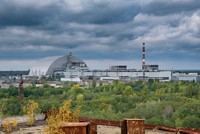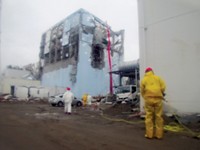Advertisement
Grab your lab coat. Let's get started
Welcome!
Welcome!
Create an account below to get 6 C&EN articles per month, receive newsletters and more - all free.
It seems this is your first time logging in online. Please enter the following information to continue.
As an ACS member you automatically get access to this site. All we need is few more details to create your reading experience.
Not you? Sign in with a different account.
Not you? Sign in with a different account.
ERROR 1
ERROR 1
ERROR 2
ERROR 2
ERROR 2
ERROR 2
ERROR 2
Password and Confirm password must match.
If you have an ACS member number, please enter it here so we can link this account to your membership. (optional)
ERROR 2
ACS values your privacy. By submitting your information, you are gaining access to C&EN and subscribing to our weekly newsletter. We use the information you provide to make your reading experience better, and we will never sell your data to third party members.
Safety
The vulnerability of nuclear
by Bibiana Campos Seijo
April 18, 2016
| A version of this story appeared in
Volume 94, Issue 16
This spring we commemorate a couple of quite important anniversaries: The first one is the fifth anniversary of Fukushima’s nuclear disaster; the second one is the 30th anniversary of the explosion of the main reactor at Chernobyl’s nuclear power plant.
Both events happened within my lifetime, and I remember those days quite vividly. In particular, I recall my whole family sitting together staring at the television watching helicopters fly over Chernobyl dropping sand, boron, and lead onto the burning reactor.
It was on April 26, 1986, that the explosion of the main reactor in Chernobyl, Ukraine—then part of the Soviet Union—took place. A reactor systems test got completely out of control and resulted in the explosion and fire of Unit 4. Tons of highly radioactive material were released into the atmosphere, contaminating nearby towns and eventually drifting over the rest of the Soviet Union and into Europe. A total of 28 workers at the plant died of radiation poisoning in the first four months; close to 335,000 people were evacuated from the most heavily contaminated areas. Cleanup activities eventually required 600,000 workers.
The triple meltdown at Fukushima Daiichi’s reactors happened on March 11, 2011. Japan was hit by a 9.0-magnitude earthquake that rocked the country for almost six minutes. The impact of this was so phenomenal that the country’s main island was moved 2 meters east. The ensuing tsunami created 40-meter-high waves that would devastate the region: 20,000 people died or went missing; hundreds of thousands lost their homes. But it didn’t stop there: The worst-ever earthquake to hit Japan also caused the worst-ever nuclear disaster in the history of the country. The tsunami caused the Fukushima Daiichi plant—situated on the east coast of the island, the worst hit—to completely lose power to cool the reactors. The emergency power generators flooded. The fuel rods began to melt down and leak radiation into the surrounding area.
These events had some things in common: Both became level 7 nuclear crises, the highest possible level on the international scale used to evaluate the seriousness of nuclear incidents, and both had catastrophic consequences. But there are many significant differences too. In terms of exposure to radiation, Chernobyl released about 10 times the radiation that was released during Fukushima: A whole reactor exploded, creating a massive radiation cloud that dispersed over a vast area in the center of the continent. Because there was no containment structure around the plant, the radiation escaped more freely. By contrast, in Fukushima much of the radioactive cloud was blown out to sea thanks to the prevailing winds.
The causes of the incidents were also very different. The Chernobyl disaster was attributed to faulty reactor design, human error, and violation of procedures. Technicians had disabled critical safety systems for an unauthorized experiment. In the case of Fukushima, it was an extreme event that was impossible to predict.
This raises an important safety question: How do you plan and prepare for the unknown and the unpredictable? You can evaluate the likelihood that a critical valve or pipe will fail or break down and create a protocol around that. But how do you create response mechanisms for events so extreme and external in nature, such as a tsunami? When planning where or how to build a nuclear facility, should we plan and prepare for earthquakes, tsunamis, or the likelihood of meteorites hitting Earth?
I don’t doubt that scientists and engineers could come up with answers and recommendations to all these questions. The issues are of course going to be difficulty of managing increased costs and implementation challenges and making nuclear a less attractive proposition by tightening regulations; e.g., think about increasing emergency planning zone sites and exclusion zones and evacuating or sheltering people. Where do you draw the line when assessing the vulnerability of a plant?
Views expressed on this page are those of the author and not necessarily those of ACS.




Join the conversation
Contact the reporter
Submit a Letter to the Editor for publication
Engage with us on Twitter